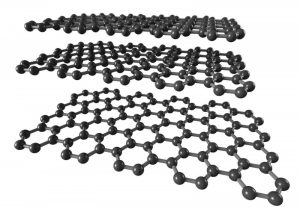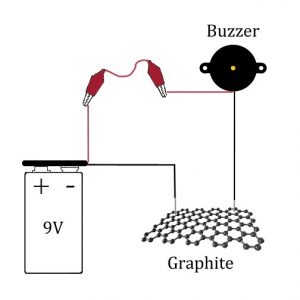Our kits are currently being reviewed and updated by a team of collaborative, innovative and interdisciplinary educators who wish to enhance the educational opportunities for students. These dedicated teachers are members of CRISP Collaborative Science for All (CCSA) as well as local educators.
Click to see the SCSU CRISP Module Template used by CCSA for improving and updating the CRISP demos and kits. Each kit page offers a CRISP developed teacher module and CRISP aligned standards (both NGSS and CCSS)
Kit Request form

Graphene is a single layer of carbon atoms arranged in a honeycomb pattern. Graphene is only one atom thick—that’s a fraction of a nanometer! (A nanometer is a billionth of a meter.) Exploring Materials – Graphene is a hands-on activity in which students use tape and graphite to make Graphene and test the conductivity of graphite. Graphene is just one form of carbon. Carbon atoms can bond together into many different structures that have very different properties.
Adapted from NanoDays Toolkits originally created for NISEnet via the NanoDays project
This material is based upon work supported by the National Science Foundation Award Numbers 0532536 and 0940143. Any opinions, findings, and conclusions expressed in this material are those of the authors and do not necessarily reflect the views of the National Science Foundation.
Subject(s):
Conductivity, Energy, Properties of Materials
Objectives:
Students will understand that:
- Graphene is a single layer of carbon atoms arranged in a honeycomb pattern.
- Graphene can be a semi-conductor.
Materials in this kit:

- Flakes of graphite
- Plastic tweezers with a pointed tip
- Scotch tape
- White activity cards (or index cards)
- Soft drawing pencils (6B is best)
- Pencil sharpener
- Battery and buzzer circuit
- “Graphene” image sheet
- Canvas bag with graphene image on it
Suggestions for the Teacher:
When assembling the buzzer and battery circuit use the alligator clip to connect the black wire of the battery to the black wire of the buzzer. Then use the red wires to touch the layer of graphite on the paper. The buzzer will not work if it is connected in the wrong direction to the battery. If the buzzer sound is faint, try putting the wires closer together on the graphite or put down a thicker layer of graphite.
If you have a molecular model set, you can build a model of graphene to supplement the illustrations in this activity.
Safety:
Students work with wires and batteries with caution.
Students should be supervised when doing this activity.
Additional Resources:
Graphene CRISP aligned standards
Graphene Teacher Module
graphene guide buzzer from NanoDays
NanoDays graphene website (Great resources!)
STEM Careers:
Standards:
HS-PS3-2
- Develop and use models to illustrate that energy at the macroscopic scale can be accounted for as a combination of energy associated with the motions of particles (objects) and energy associated with the relative positions of particles (objects).
MS-PS1-1.
- Develop models to describe the atomic composition of simple molecules and extended structures.
PS3.A: Definitions of Energy
- Energy is a quantitative property of a system that depends on the motion and interactions of matter and radiation within that system. That there is a single quantity called energy is due to the fact that a system’s total energy is conserved, even as, within the system, energy is continually transferred from one object to another and between its various possible forms.
- At the macroscopic scale, energy manifests itself in multiple ways, such as in motion, sound, light, and thermal energy.
CC-3 Scale, Proportion, and Quantity
- Time, space, and energy phenomena can be observed at various scales using models to study systems that are too large or too small.
CC-5 Energy and Matter
- Changes of energy and matter in a system can be described in terms of energy and matter flows into, out of, and within that system.
- Energy cannot be created or destroyed—only moves between one place and another place, between objects and/or fields, or between systems.
SEP 2 – Developing and Using Models
- Develop and use a model based on evidence to illustrate the relationships between systems or between components of a system.
